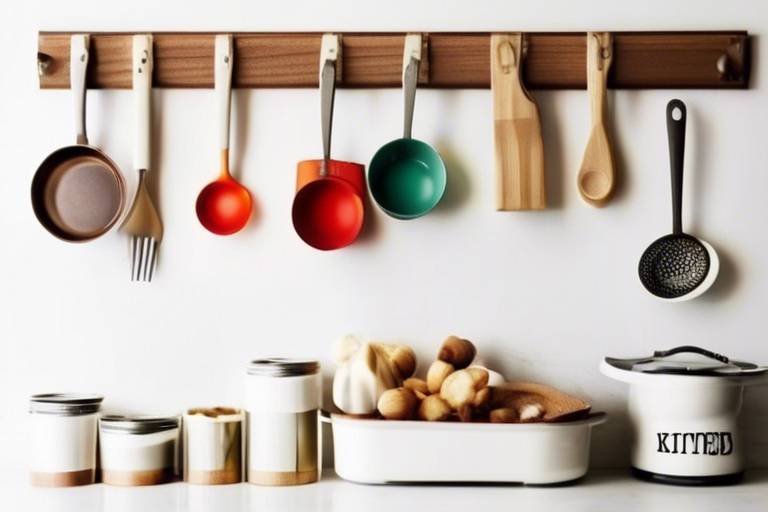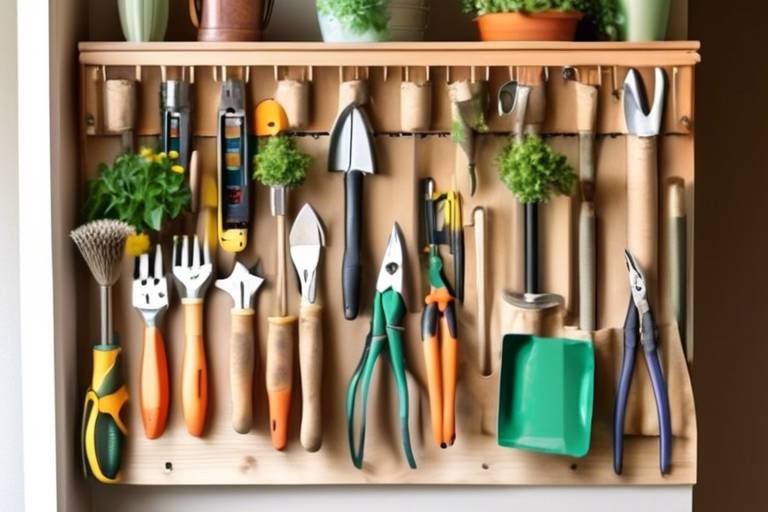10 Creative Ways to Use Leftover Paint in Crafts
Have you ever found yourself with leftover paint after a home improvement project, unsure of what to do with those colorful remnants? Don't let that paint go to waste! Get ready to unleash your creativity and dive into the world of crafting with these innovative ideas to repurpose your leftover paint.
One fantastic way to breathe new life into plain terracotta pots is by transforming them into vibrant pieces of art. With a splash of leftover paint and a brush in hand, you can turn these ordinary pots into eye-catching masterpieces that will add a pop of color to your garden.
Looking to add a personal touch to your living space? DIY wall art is the answer. Grab some canvases or wooden boards, mix and match your leftover paint colors, and let your imagination run wild. The result? A unique and personalized decor element that reflects your artistic flair.
Old furniture looking a bit tired? Give it a makeover with a fresh coat of paint using your leftover paint stash. Whether it's a worn-out chair or a dull dresser, a vibrant color transformation can breathe new life into these pieces, making them the focal point of any room.
Who knew rocks could be so versatile? Grab some ordinary stones, pick up your paintbrush, and let your creativity flow. Whether you turn them into colorful paperweights or garden decorations, painted rocks are a simple yet effective way to add a touch of whimsy to your space.
For all the green thumbs out there, customized plant markers are a fun and practical project. Grab some wooden stakes, paint them with your leftover colors, and label them with the names of your plants. Not only will they help you keep track of your garden, but they'll also add a splash of color to your green oasis.
Mason jars are a staple in any household, but why settle for plain glass when you can give them a decorative makeover? Use your leftover paint to add a pop of color and personality to these jars, turning them into stylish vases or charming storage containers.
Special occasions call for special touches, and what's more special than hand-painted greeting cards? Grab some cardstock, unleash your artistic side with leftover paint, and create one-of-a-kind cards that will surely make your loved ones smile.
Bookends don't have to be boring! Add a touch of flair to your bookshelf by painting plain bookends with your leftover paint. Whether you go for a bold color contrast or a subtle ombre effect, these painted bookends will not only keep your books in place but also serve as stylish decor pieces.
Ready to take your crafting skills to the next level? Dive into the world of painted fabric projects. Use your leftover paint to create unique designs on fabric, whether it's custom pillow covers, trendy tote bags, or even personalized clothing items. The possibilities are endless, and the results are sure to impress.

1. Painted Flower Pots
When it comes to adding a splash of color to your garden, painted flower pots are a fantastic way to showcase your creativity. By using leftover paint, you can transform plain terracotta pots into vibrant works of art that will brighten up any outdoor space. Whether you're a seasoned crafter or just looking for a fun DIY project, painting flower pots is a simple and enjoyable activity that yields beautiful results.
One creative idea is to paint geometric patterns or abstract designs on the pots using a variety of colors. You can also opt for a more whimsical approach by painting flowers, animals, or even your favorite quotes on the pots. The possibilities are endless, allowing you to let your imagination run wild and create unique pieces that reflect your personal style.
To get started, gather your leftover paint in different shades and sizes of terracotta pots. Begin by cleaning the pots thoroughly and allowing them to dry completely. Then, use a brush or sponge to apply the paint in smooth, even strokes, covering the surface of the pot with your chosen design. You can also experiment with different painting techniques, such as stenciling or splatter painting, to achieve different effects.
Once you've finished painting, let the pots dry completely before sealing them with a clear varnish to protect the paint from the elements. This step is essential to ensure that your artwork remains vibrant and intact, even when exposed to sun, rain, and wind. Once sealed, your painted flower pots are ready to be displayed in your garden, on your patio, or even indoors as colorful decor pieces.
Not only are painted flower pots a great way to use up leftover paint, but they also make wonderful gifts for friends and family. Whether you're celebrating a special occasion or just want to brighten someone's day, a hand-painted flower pot filled with a beautiful plant is a thoughtful and personalized present that will be cherished for years to come.

2. DIY Wall Art
When it comes to adding a personal touch to your living space, DIY wall art is a fantastic way to showcase your creativity. By utilizing leftover paint, you can transform plain canvases or wooden boards into unique pieces that reflect your style and personality.
Imagine turning a blank wall into a gallery of your own making, filled with colors and designs that speak to you. With just a few brush strokes and a splash of paint, you can breathe new life into any room and make a statement that is truly one-of-a-kind.
Whether you're a seasoned artist or just starting out, DIY wall art allows you to experiment with different techniques and styles without breaking the bank. It's a fun and rewarding way to express yourself while adding a touch of flair to your home decor.
From abstract paintings to intricate patterns, the possibilities are endless when it comes to creating your own wall art. You can mix and match colors, experiment with textures, and let your imagination run wild to produce pieces that are as unique as you are.
By incorporating leftover paint into your DIY wall art projects, you're not only reducing waste but also giving new life to materials that would otherwise go unused. It's a sustainable and eco-friendly way to indulge your artistic side while making a positive impact on the environment.
So, grab your paintbrushes, dust off your creativity, and get ready to transform your walls into a masterpiece that reflects your individuality and style. With DIY wall art, the only limit is your imagination.

3. Upcycled Furniture
When it comes to upcycling furniture, the possibilities are endless with leftover paint. Imagine breathing new life into that old, worn-out dresser or outdated chair with just a few strokes of vibrant color. It's like giving them a second chance to shine in your home, transforming them into statement pieces that reflect your unique style and creativity.
One creative way to use leftover paint on furniture is by color blocking. This trendy technique involves painting different sections of a piece in contrasting colors, creating a modern and eye-catching design. You can revamp a plain coffee table with bold stripes of color or give a plain cabinet a geometric makeover for a fresh new look.
Another fun idea is to stencil patterns on furniture using leftover paint. Whether you prefer floral motifs, geometric shapes, or intricate designs, stenciling allows you to add a personalized touch to your pieces. You can breathe new life into a plain desk by stenciling a delicate pattern along the edges or transform a boring wardrobe with a bold, graphic design.
For those who love a distressed look, using leftover paint to create a weathered effect on furniture can add charm and character to any piece. By layering different colors and lightly sanding the edges, you can achieve a rustic, vintage look that brings warmth and texture to your decor. Imagine a cozy farmhouse dining table with a beautifully distressed finish that tells a story of time and use.
When upcycling furniture with leftover paint, it's essential to prep and prime the piece properly for a long-lasting finish. Clean the surface, sand it lightly to ensure paint adhesion, and apply a suitable primer before painting. This extra step will help the paint adhere better and prevent chipping or peeling over time, ensuring your upcycled furniture looks stunning for years to come.
So, don't let that old side table or worn-out chair gather dust in the corner. Grab your leftover paint, unleash your creativity, and transform them into unique pieces that reflect your style and personality. Upcycling furniture with paint is not just about giving new life to old pieces; it's about adding a touch of artistry and flair to your home decor.

4. Painted Rocks
Are you tired of storing half-empty cans of paint in your garage after completing a home improvement project? Don't let that leftover paint go to waste! Get ready to unleash your creativity and explore 10 innovative ways to repurpose that paint into stunning craft projects that will add a pop of color to your life.
Transforming ordinary rocks into vibrant works of art is a fun and simple way to add a touch of whimsy to your home decor. Gather smooth rocks of various sizes and shapes, grab your leftover paint, and let your imagination run wild. Whether you choose to paint intricate patterns, inspirational quotes, or cute animal designs, painted rocks make charming decorations that can be displayed indoors or outdoors.

5. Customized Plant Markers
When it comes to adding a personal touch to your garden, customized plant markers are a fantastic way to showcase your creativity. Using leftover paint, you can transform simple wooden stakes into charming markers that not only help you identify your plants but also add a decorative element to your garden.
With a few simple materials and a dash of imagination, you can create plant markers that reflect your style and personality. Consider painting each marker in a different color or design to match the corresponding plant, making it both functional and visually appealing.
Customized plant markers also make for great gifts for fellow gardeners. You can personalize each marker with names, quotes, or even small illustrations to make them extra special. Imagine the delight on a friend's face when they see a set of beautifully painted plant markers adorning their garden!
Furthermore, these plant markers serve a practical purpose by helping you keep track of your plants' names and care instructions. By using vibrant colors and creative designs, you can make the task of plant identification a fun and enjoyable experience.

6. Decorative Mason Jars
When it comes to repurposing leftover paint, one of the most creative and versatile ideas is to use it for decorating mason jars. These simple glass containers can be transformed into stunning decorative pieces with just a few strokes of paint. Whether you want to add a pop of color to your home decor or create unique storage solutions, painted mason jars are a fun and easy DIY project that anyone can enjoy.
One way to use leftover paint on mason jars is to create a colorful ombre effect. Start by selecting a few shades of paint that complement each other, then pour a small amount of each color into separate containers. Dip the bottom of the mason jar into the darkest paint and gradually lift it out, dipping into lighter shades as you move up the jar. This technique creates a beautiful gradient effect that will instantly brighten up any room.
If you prefer a more abstract look, try splatter painting your mason jars. Simply dip a paintbrush or toothbrush into your leftover paint and flick it onto the surface of the jar. The random splatters and drips will create a playful and artistic design that is perfect for adding a touch of whimsy to your decor.
For those who love a sleek and modern aesthetic, consider using painter's tape to create geometric patterns on your mason jars. Tape off sections of the jar in different shapes and sizes, then paint the exposed areas with your leftover paint. Once the paint is dry, carefully remove the tape to reveal clean lines and crisp designs that will give your jars a contemporary edge.
If you want to take your painted mason jars to the next level, consider adding embellishments like glitter, sequins, or ribbons. These extra touches can elevate your jars from simple decorations to eye-catching statement pieces that are sure to impress. Whether you use them as vases, candle holders, or simply as decorative accents, painted mason jars are a versatile and stylish addition to any home.

7. Hand-Painted Greeting Cards
Hand-painted greeting cards are a delightful way to add a personal touch to special occasions. By using leftover paint, you can create unique designs that will make your cards stand out from the rest. Whether it's a birthday, anniversary, or just a simple thank you, hand-painted greeting cards are sure to bring a smile to the recipient's face.
When making hand-painted greeting cards, consider using different techniques such as brush strokes, stenciling, or even finger painting to create one-of-a-kind designs. Experiment with colors, patterns, and textures to make each card truly special and reflective of your creativity.
To add an extra flair to your hand-painted greeting cards, consider incorporating other elements such as glitter, sequins, or ribbons. These embellishments can enhance the overall look of the card and make it even more eye-catching.
Hand-painted greeting cards are not only a thoughtful gesture but also a fun and relaxing craft activity. Whether you're an experienced artist or just starting out, creating hand-painted greeting cards with leftover paint is a wonderful way to unleash your creativity and spread joy to your loved ones.

8. Colorful Bookends
When it comes to adding a pop of color and personality to your bookshelf, colorful bookends can make a significant impact. Instead of settling for plain and ordinary bookends, why not get creative with leftover paint and transform them into unique pieces of functional art?
Imagine how a pair of brightly painted bookends can not only hold your favorite books in place but also serve as eye-catching decor elements in your home. By using leftover paint from previous projects, you can unleash your creativity and give new life to old bookends.
One creative idea is to paint geometric patterns or abstract designs on wooden or metal bookends. You can use a variety of colors to match your existing decor or create a bold contrast that stands out. The beauty of using leftover paint is that you can experiment with different color combinations without any added cost.
If you prefer a more whimsical look, consider painting themed bookends such as galaxy-inspired designs, floral motifs, or even your favorite quotes. The possibilities are endless when it comes to customizing your bookends with leftover paint.
To add a personal touch, you can involve your family members or friends in the painting process. It can be a fun and engaging activity where everyone contributes their artistic flair to create a set of colorful bookends that reflect each person's style.
Not only are colorful bookends a practical solution for organizing your book collection, but they also serve as decorative accents that showcase your creativity and attention to detail. So, don't let that leftover paint go to waste – grab your brushes and transform ordinary bookends into extraordinary pieces of art!

9. Painted Fabric Projects
When it comes to adding a personal touch to your home decor, painted fabric projects are a fantastic way to showcase your creativity. By utilizing leftover paint, you can transform plain fabric into unique and eye-catching pieces that stand out. Whether you're looking to create custom pillow covers, tote bags, or even clothing items, the possibilities are endless when it comes to painted fabric projects.
Imagine the excitement of designing your own pillow covers with vibrant colors and intricate patterns. With just a few brush strokes and some leftover paint, you can breathe new life into plain fabric, turning it into a stunning accent piece for your living room or bedroom. Each stroke of the brush is like adding a personal touch to your home decor, making it truly one-of-a-kind.
For those who love to carry a unique style wherever they go, painted fabric tote bags are a must-try project. By painting simple canvas tote bags with leftover paint, you can create a fashion statement that is both eco-friendly and stylish. Whether you opt for bold, abstract designs or delicate floral patterns, your painted fabric tote bag will surely turn heads wherever you go.
When it comes to clothing items, painted fabric projects offer a fun and creative way to update your wardrobe. From painting custom designs on plain t-shirts to adding a pop of color to denim jackets, the possibilities are endless. With leftover paint and a dash of creativity, you can transform your plain clothing items into wearable works of art that reflect your unique style.
Experimenting with painted fabric projects allows you to unleash your creativity and explore new ways to incorporate art into your everyday life. Whether you're a seasoned crafter or a beginner looking to try something new, painting fabric with leftover paint is a rewarding and enjoyable experience that yields beautiful results.
Frequently Asked Questions
- Can I mix different colors of leftover paint together for my craft projects?
Yes, mixing different colors of leftover paint can often result in unique and vibrant shades that can enhance your craft projects. Feel free to experiment with color combinations to achieve the desired look.
- How should I store leftover paint for future use?
It is recommended to store leftover paint in airtight containers to prevent drying out. Make sure to label the containers with the color and date for easy identification. Keep the containers in a cool, dry place away from direct sunlight.
- Can I use leftover paint on outdoor projects?
Absolutely! Leftover paint can be used on a variety of outdoor projects such as garden decorations, furniture, and outdoor structures. Just ensure that the paint is suitable for outdoor use and apply a protective sealant for durability.
- Is it safe to use leftover paint for crafts?
As long as the paint is in good condition and has not expired, it is generally safe to use leftover paint for crafts. However, it is advisable to work in a well-ventilated area and take necessary precautions to avoid skin contact or inhalation of fumes.



















